Republic of China Navy
The Republic of China Navy (ROCN; Chinese: 中華民國海軍; pinyin: Zhōnghuá Mínguó Hǎijūn), also called the ROC Navy and colloquially the Taiwan Navy, is the maritime branch of the Republic of China Armed Forces (ROCAF).[1][2]
| Republic of China Navy | |||||||||||||||||||||
|---|---|---|---|---|---|---|---|---|---|---|---|---|---|---|---|---|---|---|---|---|---|
_Logo.svg.png.webp) Emblem of the Republic of China Navy | |||||||||||||||||||||
| Founded |
| ||||||||||||||||||||
| Country | |||||||||||||||||||||
| Allegiance | |||||||||||||||||||||
| Type | Navy | ||||||||||||||||||||
| Size |
| ||||||||||||||||||||
| Part of | Republic of China Armed Forces | ||||||||||||||||||||
| Colors | White Blue Red | ||||||||||||||||||||
| March |
| ||||||||||||||||||||
| Fleet | |||||||||||||||||||||
| Website | navy.mnd.gov.tw (in Chinese) | ||||||||||||||||||||
| Commanders | |||||||||||||||||||||
| Commander of the Navy | |||||||||||||||||||||
| Deputy Commanding-General | |||||||||||||||||||||
| Chief of Staff | |||||||||||||||||||||
| Insignia | |||||||||||||||||||||
| Ensign |  | ||||||||||||||||||||
| Jack | 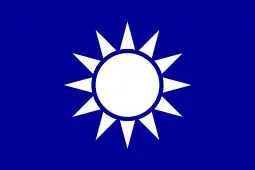 | ||||||||||||||||||||
| Chinese name | |||||||||||||||||||||
| Traditional Chinese | 中華民國海軍 | ||||||||||||||||||||
| Simplified Chinese | 中华民国海军 | ||||||||||||||||||||
| |||||||||||||||||||||
| Chinese Navy | |||||||||||||||||||||
| Traditional Chinese | 中國海軍 | ||||||||||||||||||||
| Simplified Chinese | 中国海军 | ||||||||||||||||||||
| Literal meaning | China Navy | ||||||||||||||||||||
| |||||||||||||||||||||
The service was formerly commonly just called the Chinese Navy during World War II and prior to the ROC's retreat from the mainland.[3] While still sometimes used especially in domestic circles, it is now not as often used internationally due to the current ambiguous political status of Taiwan and to avoid confusion with the People's Liberation Army Navy of the People's Republic of China (PRC).
Today, the ROC Navy's primary mission is to defend the ROC's remaining territories and the sea lanes under its jurisdiction against any possible blockades, attacks, or invasion. Operations include maritime patrols in the Taiwan Strait and surrounding waters, as well as readiness for counter-strike and counter-invasion operations during wartime. The Republic of China Marine Corps (ROCMC) also functions as a branch of the Navy.
The ship prefix for ROCN combatants is ROCS (Republic of China Ship); an older usage is CNS (Chinese Navy Ship).
Organization
Republic of China Navy Command Headquarters
_Admiral_Liu_Chih-pin_%E6%B5%B7%E8%BB%8D%E4%B8%8A%E5%B0%87%E5%8A%89%E5%BF%97%E6%96%8C_(20200116_%E6%B5%B7%E8%BB%8D%E5%8F%B8%E4%BB%A4).png.webp)
_Vice_Admiral_Hu_Zhan-hao_%E6%B5%B7%E8%BB%8D%E4%B8%AD%E5%B0%87%E8%83%A1%E5%B1%95%E8%B1%AA_(06.27_%E3%80%8C%E4%B8%AD%E8%8F%AF%E6%B0%91%E5%9C%8B106%E5%B9%B4%E4%B8%8B%E5%8D%8A%E5%B9%B4%E9%99%B8%E6%B5%B7%E7%A9%BA%E8%BB%8D%E5%B0%87%E5%AE%98%E6%99%89%E4%BB%BB%E5%B8%83%E9%81%94%E6%9A%A8%E6%8E%88%E9%9A%8E%E5%85%B8%E7%A6%AE%E3%80%8D_35174159590_be2028dccd_o).jpg.webp)
_Vice_Admiral_Tang_Hua_%E6%B5%B7%E8%BB%8D%E4%B8%AD%E5%B0%87%E5%94%90%E8%8F%AF_(06.27_%E3%80%8C%E4%B8%AD%E8%8F%AF%E6%B0%91%E5%9C%8B106%E5%B9%B4%E4%B8%8B%E5%8D%8A%E5%B9%B4%E9%99%B8%E6%B5%B7%E7%A9%BA%E8%BB%8D%E5%B0%87%E5%AE%98%E6%99%89%E4%BB%BB%E5%B8%83%E9%81%94%E6%9A%A8%E6%8E%88%E9%9A%8E%E5%85%B8%E7%A6%AE%E3%80%8D_35174159590_be2028dccd_o).jpg.webp)
The Navy CHQs (中華民國國防部海軍司令部) is subordinate to the General Staff, the Minister of Defense, and the ROC President.
- Internal units: Personnel, Combat Readiness & Training, Logistics, Planning, Combat Systems, General Affairs, Comptroller, Inspector General, Political Warfare.
- Naval Fleets Command (艦隊指揮部)
- 124th Fleet: Zuoying District, Kaohsiung City
- 131st Fleet: Keelung City, Taiwan
- 146th Fleet: Magong City, Penghu County, Taiwan
- Amphibious Fleet (151st Fleet), Zuoying District, Kaohsiung City
- 168th Fleet: Suao, Yilan County, Taiwan
- 192nd Fleet (Navy Minesweeper Fleet): Zuoying District, Kaohsiung City
- 256th Submarine Squadron: Zuoying District, Kaohsiung City
- 261st Squadron
- Hai Chiao(Sea Dragon) PGMG Guided Missile Boat/Craft Group (海蛟大隊)
- 1st Hai Chiao Guided Missile Boat/Craft Squadron of 10 Kuang Hua VI-class missile boat at Suao naval base
- 2nd Hai Chiao Guided Missile Boat/Craft Squadron of 10 Kuang Hua VI-class missile boat
- 3rd Hai Chiao Guided Missile Boat/Craft Squadron of 10 Hai Ou-class missile boat (Dvora class)
- 4th Hai Chiao Guided Missile Boat/Craft Squadron of 10 Hai Ou-class missile boat (Dvora class)
- 5th Hai Chiao Guided Missile Boat/Craft Squadron of 11 Kuang Hua VI-class missile boat[4][5]
- Hai Feng Shore Based Anti-ship Missile Group (海鋒大隊), operates 6 batteries of fixed/mobile HF-2 anti-ship missiles.
- Aviation Command (operates from Pingtung, Tsoying, and Hualien AB)
- Naval Aviation, at Pingtung, will receive 12 P-3C 2013/2014.
- 1st ASW Aviation Group
- 133rd Squadron: S-2T, at Pingtung.
- 134th Squadron: S-2T, at Pingtung.
- 2nd ASW Aviation Group
- 701st Helicopter Squadron (Light), S-70C(M)-1, at Hualien.
- 702nd Helicopter Squadron (Light), S-70C(M)-2, at Tsoying.
- 501st Helicopter Squadron (Light), 500MD ASW, at Tsoying.
- Maintenance Group
- 1st Maintenance Squadron (Pingtung)
- 2nd Maintenance Squadron (Tsoying)
- 3rd Maintenance Squadron (Hualien)
- Marine Corps Command (陸戰隊指揮部)
- Education, Training and Doctrine Command (教育訓練暨準則發展司令部)
- Logistics Command (後勤司令部)
- Naval Academy, Hydrographic & Oceanographic Bureau, Shipbuilding Development Center, Communication Systems, General Service.
History
| Republic of China Navy |
|---|
 |
| Leadership |
|
Ministry of Defense Commander of the Navy |
| Commands |
| Republic of China Marine Corps |
| Equipment |
| Ships |
| Personnel |
| Rank insignia |
| Orders, Decorations and Medals |
|
List of orders, decorations and medals Order of Blue Sky and White Sun |
| History and Traditions |
| Naval history of China |
1912–1949
The precursor to the modern ROC Navy was established as the Ministry of the Navy in the Provisional Government of the Republic of China in 1911 following the overthrow of the Qing dynasty. Liu Guanxiong, a former Qing dynasty admiral, became the first Minister of Navy of the Republic of China. During the period of warlordism that scared China in the 1920s and 1930s the ROCN remained loyal to the Kuomintang government of Sun Yat-sen instead of the warlord government in Beijing which fell to the nationalist government in the 1928 northern campaign and between the civil war with the Communist Party and 1937 Japanese invasion of Northeast China. During that time and throughout World War II, the ROCN concentrated mainly on riverine warfare as the poorly equipped ROCN was not a match to Imperial Japanese Navy over ocean or coast.[11]
Following World War II, a number of Japanese destroyers and decommissioned U.S. ships were transferred to the ROC Navy. During the Chinese Civil War, the ROCN was involved in the protection of supply convoys and the withdrawal of the ROC Government and over 1 million refugees to Taiwan in 1949. The subsequent reorganization and reestablishment of the Navy after evacuation to Taiwan is referenced in the lyrics of the post 1949 ROC Navy Song "The New Navy" (新海軍).
1945–present
In 1895, the island of Taiwan was placed under Japanese rule, with the Imperial Japanese Navy responsible for defending the waters of Taiwan and Penghu. After World War II, on 25 October 1945, the jurisdiction of Taiwan and Penghu was transferred to the Republic of China and the ROCN began its operation in that territory.
Following the relocation of the ROC government to Taiwan, the ROCN was involved in a number of commando attack escorts, evacuation and transport of more displaced soldiers and later to provide patrols and resupply operations to Kinmen and Matsu in the Taiwan Strait and South China Sea offshore islands.
Since the 1990s the Navy has grown in importance as the emphasis of the ROC's military doctrine moves towards countering a possible People's Republic of China (PRC) blockade, as well as offshore engagement. As of 2004 the ROCN had been working hard to expand its capability in electronic and anti-submarine warfare, as well as the replacement of antiquated warships and support vessels.[9] While for many years the ROCN operated hand me down and foreign designed vessels in recent years they have been operating a higher number of indigenous platforms, sensors, and weapons much of it made by the National Chung-Shan Institute of Science and Technology.[12]

In 2018 Lungteh Shipbuilding was awarded a contract to produce eleven Tuo Chiang Block II corvettes and four minelayers for the Taiwanese Navy.[13]
In April 2020 in response to the COVID-19 pandemic the ROCN cut short their semi-annual goodwill mission to Central and South America. The flotilla consisting of two frigates and a supply vessel was subject to 30 days of quarantine after returning to Taiwan.[14]
In April 2020 Taiwanese boatbuilder Karmin International Co., Ltd. won a NT$450-million (US$14.9-million) contract to supply the Republic of China Navy with eighteen special operations watercraft and eight RIB tenders, the later for the Cheng Kung-class frigates. Delivery is scheduled for June 2022. The contract covered only the watercraft themselves with their machine guns, infrared equipment, and boarding ladders sourced separately.[15]
Rank and rating insignia
Officer ranks
| Rank group | General/flag officers | Senior officers | Junior officers | Officer cadet | ||||||||||||||||||||||||||||||||
|---|---|---|---|---|---|---|---|---|---|---|---|---|---|---|---|---|---|---|---|---|---|---|---|---|---|---|---|---|---|---|---|---|---|---|---|---|
  |
  |
  |
  |
 |
 |
 |
 |
 |
 |
|||||||||||||||||||||||||||
| 一級上將 It-kip siōng-chiòng |
二級上將 Jī-kip siōng-chiòng |
中將 Tiong-chiòng |
少將 Siáu-chiòng |
上校 Siōng-hāu |
中校 Tiong-hāu |
少校 Siáu-hāu |
上尉 Siōng-ùi |
中尉 Tiong-ùi |
少尉 Siáu-ùi |
軍校生 Jūnxiào shēng | ||||||||||||||||||||||||||
Other ranks
| Rank group | Senior NCOs | Junior NCOs | Enlisted | |||||||||||||||||||||||||||||||||
|---|---|---|---|---|---|---|---|---|---|---|---|---|---|---|---|---|---|---|---|---|---|---|---|---|---|---|---|---|---|---|---|---|---|---|---|---|
 |
 |
 |
 |
 |
 |
 |
 |
 | ||||||||||||||||||||||||||||
| 一等士官長 Yīděng shìguānzhǎng |
二等士官長 Èrděng shìguānzhǎng |
三等士官長 Sānděng shìguānzhǎng |
上士 Shàngshì |
中士 Zhōngshì |
下士 Xiàshì |
上等兵 Shàngděngbīng |
一等兵 Yīděngbīng |
二等兵 Èrděngbīng | ||||||||||||||||||||||||||||
Equipment
Traditionally, most ROCN equipment has been purchased from the United States. The ships themselves have often been older, second-hand vessels without the newest technology. More recently, however, several ships have been built domestically under licence or through domestic development. The ROCN has also purchased La Fayette-class frigates from France and Zwaardvis-class submarines from the Netherlands as well as four U.S. Kidd-class (renamed Keelung) destroyers originally intended for Iran. Despite the ROCN refurbishing and extending the service life of its vessels and equipment, it has suffered from procurement difficulties due to pressures exerted by the PRC.
On 12 September 2007, an arms notification was sent to the United States Congress concerning an order for 12 P-3C Orion patrol aircraft and 3 "spare aircraft", along with an order for 144 SM-2 Block IIIA surface-to-air missiles.[17] A contract was awarded to Lockheed Martin to refurbish the 12 P-3C Orion aircraft for the ROC on 13 March 2009, with deliveries to start in 2012.[18]
In 2008, the ROCN set out to acquire an improved anti-ship capability. On 26 August, an arms notification was sent to Congress for an order for 60 air-launched Harpoon Block II missiles for the 12 P-3Cs.[19] At least a portion of these missiles will be installed on the navy's Hai Lung-class submarines.
On 29 January 2010, the U.S. government announced five notifications to the U.S. Congress for arms sales to the ROC. In the contracts total US$6.392 billion, ROC Navy would get 2 Osprey-class minehunters for US$105 million, 25 Link 16 terminals on ships for US$340 million, 10 ship- and 2 air-launched Harpoon L/II for US$37 million.[20][21]
The ROC Navy already has 95 older Harpoon missiles in its inventory for the 8 Knox-class frigates, 22 newer RGM-84L for the 4 Kidd-class destroyers, 32 sub-launched Harpoon II on order for the 2 Hai Lung-class submarines, and with 60 air-launched Harpoon Block II anti-ship missile on order for the 12 P-3Cs, plus the newly announced 10 ship-launched and 2 air-launched Harpoon II/L sales.[22]
On 31 August 2010, it was announced for the next year's defense budget, ROCN planned to lease one or two more Newport-class tank landing ships (LST) from the United States, but the 900-ton stealth corvette plan was put on hold, due to lack of funds.[23] That same year, On 29 September, the U.S. Congress passed a resolution, authorizing the U.S. Government for the sale of one more Osprey-class minehunter to the ROC.[24]
Other ongoing local upgrade programs include locally designed and built Ching Chiang class of 12 patrol ships. Since 2006, seven ships of this class were upgraded to carry four HF-2/3 with W-160 fire control radar from Wu Chin III program (as well as Honeywell H-930 MCS CDS stripped from seven retired Yang-class Wu Chin 3 anti-air warfare destroyers). In 2010 more ships of this class were undergoing this same upgrade program but using CSIST produced fire control radars instead.
_leaving_Mayport_in_January_2014.JPG.webp)
On 29 December 2010, two LSTs (中肇、中治戰車登陸艦) and four remaining of Adjutant-class coastal minehunters were retired.[25]
In 2011, the navy retired several vessels. On 31 October, all eight PCL in the 124th Fleet were retired.[26] On 28 December, the two Lung Jiang-class (PSMM Mk5) guided missile patrol boats (PGG 601 and PPG 602) of the 131st Fleet were retired from ROC Navy service, after entering service in 1978 and 1981 respectively.[27]
In June 2018, two Oliver Hazard Perry-class frigates of the US Navy, ex-USS Taylor and ex-USS Gary, were handed over to the Government of Taiwan for the Republic of China Navy. The transfer cost was an estimated US$177 million. The transfer of the ships includes the advanced AN/SQR-19 Multi-Function Towed array sonar. Taiwan had previously been blocked from acquiring the AN/SQR-19, and the transfer of the system points to an anti-submarine focus in line with the Knox-class frigates they will likely replace.[28]
The keel of a new rescue and salvage ship was laid in March 2022.[29]
12 new domestically built frigates for the Taiwanese Navy[30]
Indigenous "Landing Platform Dock" / Amphibious Assault Ship

In September 2018, Taiwan confirms contract for first amphibious assault ship built in Taiwan. It will be built by CSBC Corporation, a local shipyard. Four are planned with the first to be entering service around 2021. It is roughly similar to US Navy's San Antonio-class, but with a slightly smaller displacement. Support features include a full hospital, well deck, full aviation facilities, storage for wheeled vehicles, and dedicated accommodations for a full battalion of Marines.[31] The vessel design will be armed with a 76 mm naval gun in the primary position, a close-in weapon system (CIWS) turret, two 12.7 mm machine gun positions in the forward section, and launchers that can deploy the Hsiung Feng II and III family of anti-ship and land-attack cruise missiles.[32][33][34] The primary sensor is expected to be a naval version of the indigenous CS/MPQ-90 Bee Eye AESA radar.[35]
Fleet Air Defense Upgrade / Hsun Lien Project
The ROC Navy currently lacks a modern fleet defense system. Keelung class destroyers currently use obsolete Mark 26 missile launchers designed from the 1970s and does not currently have a modern centralized air defense combat system like the Aegis.[36][37] Past US administrations rejected the sale of Aegis radar system and Arleigh Burke-class destroyers, including George W. Bush in 2001. Under the George W. Bush administration, the US instead sold Taiwan four Kidd-class destroyers, which did not carry the Aegis and were no longer in service in the US Navy at the time.[38][39][40] However, in January 2019, the US government delivered two sets of Mk 41 VLS to Taiwan. The ROC government plans to integrate the MK41 VLS and locally developed Tien-Kung III (Sky Bow III) with its indigenously developed Hsun Lien naval combat system, which is similar to Aegis, to upgrade its ship air defense capabilities.[41][42] Taiwan has acquired the license and technology to produce additional MK 41 VLS launchers. The ROC Navy currently as of 2019 possesses at least 14 warships compatible with the Mk41.[43] In November 2019 it was reported that the decommissioned amphibious landing ship Kao Hsiung (LCC-1) was being used as a test ship for the Hsun Lien naval combat system project and had been fitted with a large phased array radar system and the Mark 41 Vertical Launching System.[44] In January 2020, it is reported the Tien-Kung III (Sky Bow III) is successfully fired from the Mark 41 Vertical Launching System.[45][46]
Hai Kun-class submarine (formerly: Indigenous Defense Submarine Program)
In November 2020, President Tsai Ing-wen opened the submarine construction facility in Kaohsiung with plans to build eight submarines. Construction was to begin with a prototype boat which was to be built over 78 months. The first boat is scheduled to enter service in 2025.[47][48] Between December 2020 and February 2021, the United States reportedly approved the export of three key systems to Taiwan for the program: digital sonar systems, integrated combat systems and auxiliary equipment systems (periscopes).[49]
In 2023, Taiwan revealed its first domestically designed and built submarine, the Hai Kun.[50]
Destroyers (4 in service)
| Class | Picture | Type | Ships | Displacement[lower-alpha 1] | Note |
|---|---|---|---|---|---|
| Kee Lung-class | _and_Ma_Kong_(DDG-1805)_shipped_in_Zhongzheng_Naval_Base_20130504b.jpg.webp) |
ROCS Kee Lung (DDG-1801) ROCS Su Ao (DDG-1802) ROCS Tso Ying (DDG-1803) ROCS Ma Kong (DDG-1805) |
9,574 tonnes | Formerly Kidd-class destroyer in US Service built in 1978. Originally built for the Imperial Iranian Navy. | |
Frigates (22 in service)
| Class | Picture | Type | Ships | Displacement[lower-alpha 1] | Note |
|---|---|---|---|---|---|
| Cheng Kung-class | 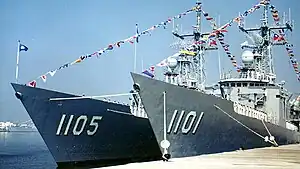 |
ROCS Cheng Kung (PFG2-1101) ROCS Cheng Ho (PFG2-1103) ROCS Chi Kuang (PFG2-1105) ROCS Yueh Fei (PFG2-1106) ROCS Tzu I (PFG2-1107) ROCS Pan Chao (PFG2-1108) ROCS Chang Chien (PFG2-1109) ROCS Tian Dan (PFG2-1110) ROCS Ming Chuan (PFG-1112) ROCS Feng Jia (PFG-1115) |
4,105 tonnes | Eight licensed ships based on US Oliver Hazard Perry class built. Two additional ex-US Navy ships (ROCS Ming Chuan & ROCS Feng Jia ) | |
| Kang Ding-class | 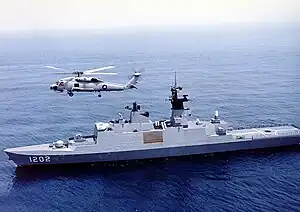 |
ROCS Kang Ding (PFG-1202) ROCS Si Ning (PFG-1203) ROCS Kun Ming (PFG-1205) ROCS Di Hua (PFG-1206) ROCS Wu Chang (PFG-1207) ROCS Chen De (PFG-1208) |
3,600 tonnes | French-built La Fayette class | |
| Chi Yang-class |  |
ROCS Fong Yang (FF-933) ROCS Fen Yang (FFG-934) ROCS Lan Yang (FFG-935) ROCS Hwai Yang (FFG-937) ROCS Ning Yang (FFG-938) ROCS Yi Yang (FFG-939) |
4,260 tonnes | Ex-Knox class |
Corvettes (9 in service;4 in building)
| Class | Picture | Type | Ships | Displacement[lower-alpha 1] | Note |
|---|---|---|---|---|---|
| Ching Chiang-class |  |
ROCS Kao Chiang (PG-609) ROCS Jin Chiang (PG-610) ROCS Hsiang Chiang (PG-611) ROCS Po Chiang (PG-614) ROCS Chang Chiang (PG-615) ROCS Chu Chiang (PG-617) |
500 tonnes | Delivery began 1999-2000 | |
| Tuo Chiang-class |  |
ROCS Tuo Chiang (PGG-618) ROCS Ta Chiang (PGG-619) ROCS Fu Chiang (PGG-620) |
600 tonnes | Lead ship delivered in March 2014.[53] |
Fast attack missile craft (31 in service)
| Class | Picture | Type | Ships | Displacement[lower-alpha 1] | Note |
|---|---|---|---|---|---|
| Kuang Hua VI-class | 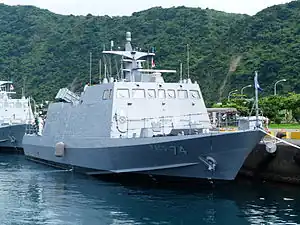 |
missile boat |
FACG-60~66 FACG-68~75 FACG-77~84 FACG-86~93 |
186.5 tonnes | Delivery began 2003 |
Mine warfare vessels (11 in service)
| Class | Picture | Type | Ships | Displacement[lower-alpha 1] | Note |
|---|---|---|---|---|---|
| Yung Feng-class | _Shipped_at_No.7_East_Pier%252C_Zuoying_Naval_Base_20161112a.jpg.webp) |
ROCS Yung Feng (MHC-1301) ROCS Yung Chia (MHC-1302) ROCS Yung Nien (MHC-1303) ROCS Yung Shun (MHC-1305) |
558.3 tonnes | MWW-50 class, built anew in Germany in early 1990s[54] | |
| Yung Yang-class | .jpg.webp) |
ROCS Yung Yang (MSO-1306) | 735 tonnes | ex-Aggressive class. 1 vessel still in active commission (ROCS Yung Tzu (MSO-1307) ROCS Yung Ku (MSO-1308) ROCS Yung Teh (MSO-1309) have been decommissioned.) | |
| Yung Jin-class | _Shipped_in_Zhongzheng_Naval_Base_20130504a.jpg.webp) |
ROCS Yung Jin (MHC-1310) ROCS Yung An (MHC-1311) |
893 tonnes | ex-Osprey class | |
| Min Jiang-class | 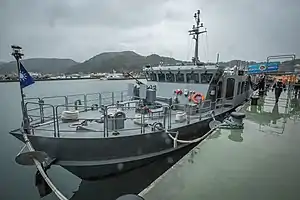 |
FMLB-1 FMLB-2 FMLB-3 FMLB-5 |
347 tons | Built in Taiwan by Lung Teh Shipbuilding, 2020-2021[55] |
Amphibious ships (9 in service)
| Class | Picture | Type | Ships | Displacement[lower-alpha 1] | Note |
|---|---|---|---|---|---|
| Newport class |  |
tank landing ship |
ROCS Chung Ho (LST-232) ROCS Chung Ping (LST-233) |
8,450 tonnes | ex-USN USS Manitowoc (LST-1180) and USS Sumter (LST-1181) |
| Chung Hai-class | .jpg.webp) |
tank landing ship |
ROCS Chung Chien (LST-205) ROCS Chung Chie (LST-218) ROCS Chung Ming (LST-227) ROCS Chung Yeh (LST-231) |
4,080 tonnes | Landing Ship, Tank (LST-1) |
| Kaohsiung-class | _Shipped_in_No.1_Pier_of_Zhongzheng_Naval_Base_Right_Front_View_20130504.jpg.webp) |
amphibious command ship |
ROCS Kao Hsiung (AGC-1) | 3,698 tonnes | ex-USS Dukes County (LST-735), an LST-542-class tank landing ship |
| Hsu Hai-class | _transiting_the_Atlantic_Ocean_on_12_August_1988.jpg.webp) |
dock landing ship |
ROCS Hsu Hai (LSD-193) | 13,700 tonnes | ex-USS Pensacola (LSD-38), an Anchorage-class dock landing ship |
| Yushan-class |  |
Amphibious transport dock |
ROCS Yus han (LPD-1401) | 10,600 tonnes |
Submarines (4 in service; 1 in building)
| Class | Picture | Type | Boats | Displacement[lower-alpha 1] | Note |
|---|---|---|---|---|---|
| Chien Lung-class | 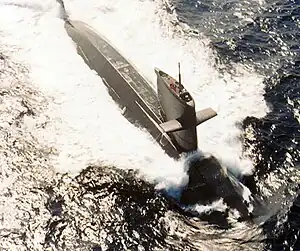 |
Diesel-electric submarine |
ROCS Hai Lung (SS-793) ROCS Hai Hu (SS-794) |
2,660 tonnes | Based on Zwaardvis-class submarine. These are also known by the lead ship's name as the Hai Lung-class. |
| Hai Shih-class (Tench-class) |
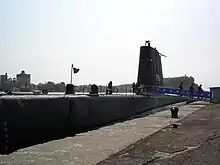 |
Diesel-electric submarine |
ROCS Hai Shih (SS-791) (ex-USS Cutlass) ROCS Hai Bao (SS-792) (ex-USS Tusk) |
2,420 tonnes | Used primarily for training. World's oldest longest-serving submarines.[56] Has two (one for each submarine) of the three remaining working Arma gyrocompass in the world.[57] Expected to be retired after construction of IDS project boats. |
| Hai Kun-class | 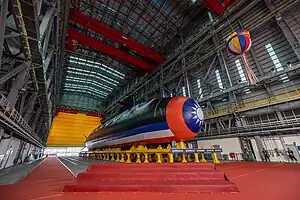 |
Diesel-electric submarine |
ROCS Hai Kun (SS-711) | 2,500 tonnes | First domestically developed submarine.[58] |
Auxiliary ships (8 in service;1 in building)
| Class | Picture | Type | Boats | Displacement[lower-alpha 1] | Note |
|---|---|---|---|---|---|
| Pan Shi-class | _at_Zuoying_Naval_Base_20151024.jpg.webp) |
fast combat support ship |
ROCS Pan Shi (AOE-532) | 20,895 tonnes | AOE-532 |
| Wu Yi-class | 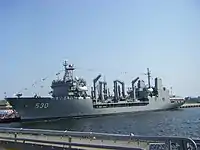 |
fast combat support ship |
ROCS Wu Yi (AOE-530) | 17,000 tonnes | AOE-530 |
| Ta Kuan-class | 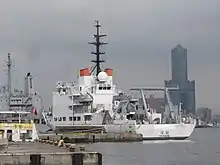 |
ROCS Ta Kuan (AGS-1601) | 3,200 tonnes | Oceanographic measurement | |
| Ta Hu-class (Diver-class) | 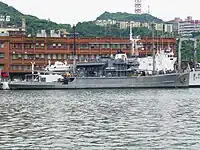 |
rescue and salvage ship |
ROCS Da Hu (ARS-552) (ex-USS Grapple) ROCS Da Juen (ARS-556) (ex-USS Recovery) |
1,975 tonnes | Expected to be retired after the construction of the An-hai Project |
| Ta Tung-class (Cherokee-class) | 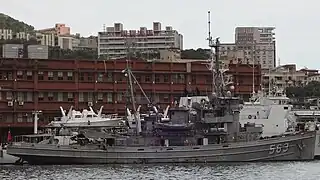 |
ROCS Ta Wan (ATF-551) (ex-USS Apache) ROCS Da Gang (ATF-554) (ex-USS Achomawi) ROCS Da Tai (ATF-563) (ex-USS Shakori) |
1,680 tonnes | Consisted of ex-USN Navajo-class and Abnaki-class tugboat. Expected to be retired after the construction of the An-Hai Project |
Aircraft
Fixed-wing
| Name | Origin | Type | Variant | In service | Notes |
|---|---|---|---|---|---|
| Lockheed P-3 Orion | Maritime patrol | P-3C | 12 | Re-built ex-US Navy aircraft and replaced ROCN Grumman S-2 Trackers | |
| Lockheed EP-3 ARIES | Signals reconnaissance | EP-3E | 3 | Spare P-3C airframes acquired for future conversion to EP-3E Aries I of II platform | |
| NCSIST Albatross | Reconnaissance UAV | 26 | In service as of 2019[59] |
Helicopters
| Name | Origin | Type | Variant | In service | Notes |
|---|---|---|---|---|---|
| Sikorsky S-70 | Search and rescue / Anti-submarine warfare | S-70C(M)-1/2 Thunderhawk | 18[60] | 10 on order[60] | |
| McDonnell Douglas MD 500 Defender | Anti-submarine warfare | 500MD/ASW Defender | 7[60] | Out of original 13 ordered |
Surface-to-air missiles
| Name | Origin | Type | Notes |
|---|---|---|---|
| Sky Sword I | Short-range | Shipboard deployment with Sea Oryx system. | |
| Sky Sword II | Medium-range | Unknown number of TC-2N, to be fielded on Tuo Chiang Block II corvettes and retrofitted on the Kang Ding-class frigates.[61] | |
| RIM-66 SM-1MR | Medium-range | 97 RIM-66B Standard-1MR delivered in 1993, 207 RIM-66B Standard-1MR delivered in 1994, 204 RIM-66B Standard-1MR delivered in 2001[62] | |
| RIM-66 SM-2MR | Medium-long range | 148 Standard Missile-2MR delivered in 2005, 144 Standard Missile-2MR delivered in 2008, 16 Standard Missile-2MR ordered in 2017[62] | |
| RIM-72C Sea Chaparral | Short-range | Deployed on some domestic warships as well as La Fayette Frigates. To be replaced.[63] |
Anti-ship missiles
| Name | Origin | Type | Notes |
|---|---|---|---|
| AGM-84 Harpoon | Subsonic | (183) AGM-84s – (60) 84Ls[62] | |
| Hsiung Feng II | Subsonic | Unknown, in mass production with secondary ground attack capability[64] | |
| Hsiung Feng III | Supersonic | Unknown, in mass production with secondary ground attack capability |
CIWS
| Name | Origin | Type | Notes |
|---|---|---|---|
| Phalanx CIWS | Gun System | 20mm, 7 Mk-15 delivered in 1989, 6 Mk-15 delivered in 1996, 1 Mk15 delivered in 2014, 13 Mk15 delivered in 2016, 11 Mk15 delivered in 2018[62] | |
| XTR-101/102 | Gun System | 20mm, more than 20 systems deployed in coastal defenses.[65] |
Torpedoes
| Name | Origin | Type | Notes |
|---|---|---|---|
| Mark 46 torpedo | Lightweight | 100 delivered in 1992, 150 Mk-46 Mod-5 NEARTIP delivered in 1994, 110 Mk-46 Mod-5 NEARTIP delivered in 1998, 90 Mk-46 Mod-5 NEARTIP delivered in 2000, 41 Mk-46 Mod-5 NEARTIP delivered in 2001[62] | |
| Mark 48 torpedo | Heavyweight | 46 ordered in 2018[62] | |
| SUT torpedo | Heavyweight | multirole, 200 delivered in 1998 from Indonesian production line[62] |
Gallery
 Hsiung Feng II and Hsiung Feng III launchers of Tian Dan (PFG2-1110)
Hsiung Feng II and Hsiung Feng III launchers of Tian Dan (PFG2-1110) Sea Oryx missile launcher display at MND Hall
Sea Oryx missile launcher display at MND Hall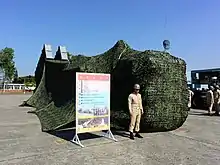 Covered ROCN Hsiung Feng II & Hsiung Feng III anti-ship missile launchers truck displayed at Zuoying Naval Base
Covered ROCN Hsiung Feng II & Hsiung Feng III anti-ship missile launchers truck displayed at Zuoying Naval Base ROCN Hsiung Feng II & Hsiung Feng III anti-ship missile launchers truck
ROCN Hsiung Feng II & Hsiung Feng III anti-ship missile launchers truck Hsiung Feng III anti-ship missile launched from a missile launchers truck
Hsiung Feng III anti-ship missile launched from a missile launchers truck_Helicopter_Deck_Rear_Right_View_20141123.jpg.webp) ROCN Hughes 500 "6910" carried on Lan Yang (FFG-935) helicopter deck from rear right view
ROCN Hughes 500 "6910" carried on Lan Yang (FFG-935) helicopter deck from rear right view_2307_Flying_over_Zuoying_Naval_Base_in_Morning_20141123a.jpg.webp) ROCN S-70C(M) "2307" flying over Zuoying Naval Base in the morning
ROCN S-70C(M) "2307" flying over Zuoying Naval Base in the morning_Right_Side_20130504.jpg.webp) Mark 32 torpedo tubes mounted on ROCN Tzu I (PFG-1107)
Mark 32 torpedo tubes mounted on ROCN Tzu I (PFG-1107)_20151024.jpg.webp) No.1 Wan Xiang CAPTOR mine displayed aboard ROCN Ho Zhong (LCU-484)
No.1 Wan Xiang CAPTOR mine displayed aboard ROCN Ho Zhong (LCU-484)_20151024b.jpg.webp) No.2 Wan Xiang Bottom mine displayed aboard ROCN Ho Zhong (LCU-484)
No.2 Wan Xiang Bottom mine displayed aboard ROCN Ho Zhong (LCU-484)_20150316.jpg.webp) Sea Chaparral launcher mounted on ROCN Si Ning (PFG-1203)
Sea Chaparral launcher mounted on ROCN Si Ning (PFG-1203)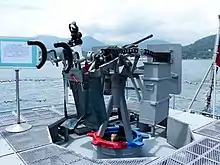 T-75S 20mm Cannon mounted on ROCS FACG-77
T-75S 20mm Cannon mounted on ROCS FACG-77_20151024.jpg.webp) Phalanx CIWS and Bofors 40 mm L/70 gun aboard on ROCN Di Hua (PFG-1206)
Phalanx CIWS and Bofors 40 mm L/70 gun aboard on ROCN Di Hua (PFG-1206) M96 motorboat
M96 motorboat The President of Taiwan aboard the Pan Shi
The President of Taiwan aboard the Pan Shi_20150316.jpg.webp) OTO Melara 76mm Gun aboard the frigate ROCN Si Ning (PFG-1203)
OTO Melara 76mm Gun aboard the frigate ROCN Si Ning (PFG-1203)_2312_Display_at_Zuoying_Naval_Base_Ground_20151024a.jpg.webp) ROCN S-70C(M) "2312"
ROCN S-70C(M) "2312"_20151024.jpg.webp) Visitors in front of ROCN Kao Hsiung (LCC-1)
Visitors in front of ROCN Kao Hsiung (LCC-1)
Bases



- Tsoying Naval Base – 1st Naval District HQ, largest naval base in Taiwan and naval airfield near Kaohsiung
- Tsoying Naval Airfield and Naval Yard – Tsoying District
- Makung Naval Base (Makung, Pescadores) – 2nd Naval District HQ – home to attack squadrons, training centre and naval yard
- Keelung Naval Base, Keelung – 3rd Naval District HQ, home to northern patrol and transport squadrons and small naval yard
- Suao Naval Base, Su-ao, Yilan – East Coast Command and supports Keelung Naval Base
All remaining bases are small naval stations supporting PCL class small patrol boats and Fast Attack Boat:
Naval Maritime and Surveillance Command
The Naval Maritime and Surveillance Command overseas a network of surveillance radar stations across Taiwan. These include high altitude sites like Hsiaohsuehshan which is located at more than 3,000m above sea level. The high altitude sites pose unique challenges to the Navy as they are often located in inaccessible areas and experience extreme weather including months of snow in the winter.[66]
In May 2021 the navy ordered a new series of shore based medium-to-long range maritime surveillance radars from NCSIST. Because the radar system will likely come under attack in a war the navy has been pulling staff back to central command centers.[67]
See also
- List of Republic of China Navy ships
- Ministry of National Defense (Republic of China)
- Republic of China Naval Academy
- Coast Guard Administration (Taiwan)
- Political status of Taiwan
- People's Liberation Army Navy (PLAN) – The naval forces of the People's Republic of China (PRC)
- Republic of China Navy rank and rating insignia for the rank and rating system of the ROCN (Including the Marine Corps)
- Maritime industries of Taiwan
- Taiwan frigate scandal
Notes
- Displacement when submerged
References
- "Taiwan navy under fire for letting sailors infected with coronavirus into community". South China Morning Post. Retrieved 19 May 2020.
- Makichuk, Dave (16 December 2020). "Taiwan's new corvette warships come heavily armed". Asia Times. Retrieved 12 September 2021.
- "The Month In Free China". taiwantoday.tw.
- "First KH-6 squadron entered service as 5th Sea Dragon Squadron". Central News Agency. Archived from the original on 2015-09-23. Retrieved 2010-05-18.
- "First KH-6 squadron entered service". pchome.com.tw. Archived from the original on 2015-04-02. Retrieved 2010-05-18.
- "Red Roof Tiles and White Walls, Hidden Missile Base Next To Hotel". United Daily News. Archived from the original on 2010-12-21. Retrieved 2010-12-23.
- "Navy opens missile base in eastern Taiwan to media". The China Post. Archived from the original on 2010-12-25. Retrieved 2010-12-23.
- "ROC Navy opens missile base in eastern Taiwan to media". China Defense Blog. 2010-12-20. Archived from the original on 2011-04-28. Retrieved 2010-12-23.
- "2004 National Defense Report" (PDF). ROC Ministry of National Defense. 2004. Archived from the original (PDF) on March 11, 2006. Retrieved 2006-03-05.
- "Combat Units Under the ROC Navy Fleet HQ". Taiwanmilitary.org. Archived from the original on 2006-07-18. Retrieved 2006-03-08.
- "歷史傳承 (History)". ROC Navy. Retrieved 2006-03-08.
- Lundquist, Edward (23 April 2019). "World Navies: Taiwan develops indigenous combat capabilities". www.marinelink.com. Marine Link. Retrieved 19 April 2020.
- Everington, Keoni (4 December 2018). "Taiwanese domestic shipbuilder gets bid to build 11 corvettes, 4 minelayers". taiwannews.com. Taiwan News.
- "Taiwan Navy's goodwill mission cut short due to COVID-19". www.taiwannews.com.tw. Taiwan News. 8 April 2020. Retrieved 12 April 2020.
- Strong, Matthew (15 April 2020). "Taiwanese company wins Navy contract for special operations craft". www.taiwannews.com.tw. Taiwan News. Retrieved 15 April 2020.
- "Lùhǎikōng jūnfú zhì tiáolì fù tú" 陸海空軍服制條例附圖 [Drawings of the Uniform Regulations of the Army, Navy and Air Force] (PDF). Gazette of the Presidential Palace (6769): 65–67. 7 November 1996. Archived from the original (PDF) on 6 March 2017. Retrieved 15 August 2022.
- "Pentagon could make 2.2 billion dollar arms sales to Taiwan". Yahoo! news. 2007-09-13. Retrieved 2007-09-13.
- "U.S. in deal to refurbish aircraft for Taiwan". Washington Post. 2009-03-13. Retrieved 2007-09-13.
- Jennings, Ralph (2008-08-27). "U.S. to sell anti-ship missiles to Taiwan". Reuters. Archived from the original on 2012-09-07. Retrieved 2017-07-01.
- "USDA New Release" (PDF). dsca.mil. 2010-01-29. Archived from the original (PDF) on 2011-07-21. Retrieved 2010-01-29.
- "USDA New Release" (PDF). dsca.mil. 2010-01-29. Archived from the original (PDF) on 2011-07-21. Retrieved 2010-01-29.
- "armstrade.sipri.org". Archived from the original on 2010-04-14. Retrieved 2010-01-10.
- "Next Year Defense Budget Believed To Be Lowest In 5 Years". United Daily newspaper. 2010-08-31. Archived from the original on 2010-08-31. Retrieved 2010-09-12.
- "US Congress approved sales of mine hunter to Taiwan". United Daily News. 2010-09-30. Archived from the original on 2010-10-03. Retrieved 2010-09-30.
- "6 Navy ships retired". Youth Daily News. 2010-12-29. Archived from the original on 2011-07-28. Retrieved 2010-12-29.
- "All 8 Navy PCL Retired Into History". Military News Agency. 2011-10-31. Archived from the original on 2012-04-25. Retrieved 2011-11-01.
- "2 Lung Jiang Missile Guided Patrol Boats Retired". United Daily News. 2011-12-28. Archived from the original on 2012-07-16. Retrieved 2012-01-03.
- Taiwan receives two US Navy frigates, Mike Yeo, DefenseNews, 2018-06-14
- Chen, Kelvin (15 March 2022). "Taiwan begins construction of naval auxiliary rescue and salvage ship". taiwannews.com.tw. Taiwan News. Retrieved 5 April 2022.
- "Taiwan to Begin Light Frigate Construction in June". 22 May 2023.
- Lundquist, Edward H. "Interview with Adm. Richard Chen, Republic of China Navy (Ret.)". Defense Media Network. Retrieved 8 August 2019.
- "Kaohsiung Maritime 2018: Taiwan confirms contract for first amphibious assault ship". Archived from the original on 2019-07-09. Retrieved 2019-07-09.
- "Kaohsiung Maritime 2018: CSBC reveals further details of LPD on order for Taiwan". Archived from the original on 2019-07-09. Retrieved 2019-07-09.
- "Taiwan will Build its first Indigenous 'Landing Platform Dock' Warship". 2017-04-20.
- Yeo, Mike (2017-08-08). "Taiwan's Navy seeks first indigenous landing platform dock". www.defensenews.com. Defense News. Retrieved 4 August 2019.
- "Taiwanese Navy Plans to Enhance Fleet Air Defense". 2016-06-06.
- "Taiwan and missile defence: Current situation and future prospects". 2018-02-28.
- Mufson, Steven; Kaiser, Robert G. (March 21, 2001). "China Warns U.S. on Warship Sale to Taiwan" – via www.washingtonpost.com.
- "Bush Won't Sell Advanced Radar System to Taiwan". Los Angeles Times. 2001-04-24.
- "Bush rejects sale of Aegis". 24 April 2001.
- "Alert 5 » Two sets of Mk 41 VLS delivered to Taiwan, will be integrated with indigenous anti-air missiles - Military Aviation News". 24 January 2019.
- "【獨家】兩套「Mk 41 VLS」運抵高雄 中科院將執行海弓三實彈驗證及整合測試 -- 上報 / 調查".
- "New Missile Launchers Won't Save Taiwan's Navy". 2019-01-28.
- Everington, Keoni (20 November 2019). "Mysterious radar ship spotted off coast of S. Taiwan". www.taiwannews.com.tw. Taiwan News. Retrieved 2 December 2019.
- "Taiwan has successfully test-fired TK-3 from Mk 41 VLS – Alert 5". 15 January 2020.
- "News Story". UDN News.
- "Taiwan starts building its own submarine fleet". South China Morning Post. November 29, 2020.
- Newdick, Thomas (25 November 2020). "Taiwan Is Finally Set To Build The New Diesel-Electric Submarines It Desperately Needs". The Drive.
- Chung, Lawrence. "Biden gives Taiwan a boost with submarine technology it can't build on its own". Business Insider.
- Garcia, Carlos; Berrazeg, Walid; Wu, Sarah (September 28, 2023). "Taiwan reveals first domestically made submarine in defence milestone". Reuters.
- "US plans to sell warships to Taiwan". Yahoo News. Archived from the original on 2015-12-19. Retrieved 2015-12-17.
- "Taiwan's Force Modernization: The American Side". Defense Industry Daily. 21 July 2015. Archived from the original on 20 November 2016. Retrieved 30 January 2016.
- Rahmat, Ridzwan (13 March 2014). "Taiwan launches first 'carrier killer' stealth missile corvette". IHS Jane's 360. Archived from the original on 2014-12-18. Retrieved 2019-07-16.
- "World Navies Today: Taiwan (Republic of China)".
- Chen, Kelvin (17 December 2021). "Taiwan Navy receives final pair of rapid mine-laying ships". www.taiwannews.com.tw. Taiwan News. Retrieved 17 December 2021.
- "Taiwan public gets glimpse of world's lon". 30 September 2019.
- "Museum documents an operating US, WW II built submarine in Taiwan".
- Garcia, Carlos; Berrazeg, Walid; Wu, Sarah (September 28, 2023). "Taiwan reveals first domestically made submarine in defence milestone". Reuters.
- and Evelyn Kao, Wang Cheng-chung. "Albatross drone makes first fly-over demonstration in Pingtung". focustaiwan.tw. Focus Taiwan. Retrieved 17 January 2020.
- "World Air Forces 2021". FlightGlobal. 4 December 2020. Archived from the original on 10 February 2021. Retrieved 27 February 2021.
- Lundquist, Edward H. "Interview with Adm. Richard Chen, Republic of China Navy (Ret.)". www.defensemedianetwork.com. Defense Media Network. Retrieved 2 August 2019.
- "TRADE REGISTERS". sipri.org. Stockholm International Peace Research Institute. Retrieved 19 April 2019.
- Hsu, Tso-Juei (22 February 2021). "Taiwan To Upgrade Its La Fayette Frigates With New Air Defense & Combat Systems". www.navalnews.com. Naval News. Retrieved 28 April 2021.
- "Hsiung Feng II". csis.org. Center for Strategic and International Studies. Archived from the original on 2 April 2019. Retrieved 2 April 2019.
- Ko Lin, Matt Yu and. "Taiwan's Navy places order for locally built anti-ship guns". focustaiwan.tw. Focus Taiwan. Retrieved 27 April 2021.
- Chin, Jonathan (16 October 2018). "Navy radar station guards west coast from mountain top". www.taipeitimes.com. Taipei Times. Retrieved 1 December 2020.
- Strong, Matthew (13 May 2021). "Taiwan Navy orders new radar system from domestic manufacturer". www.taiwannews.com.tw. Taiwan News. Retrieved 15 May 2021.
